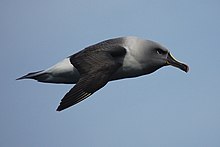Light-mantled Albatross
| Light-mantled Albatross | |
|---|---|
 | |
| Light-mantled Albatross in flight | |
| Conservation status | |
| Scientific classification | |
| Kingdom: | Animalia |
| Phylum: | Chordata |
| Class: | Aves |
| Order: | Procellariiformes |
| Family: | Diomedeidae |
| Genus: | Phoebetria |
| Species: | P. palpebrata |
| Binomial name | |
| Phoebetria palpebrata (Forster, 1785) | |
| Synonyms | |
Diomedea palpebrata
| |
The Light-mantled Albatross, Phoebetria palpebrata, also known as the Grey-mantled Albatross or the Light-mantled Sooty Albatross, is a small albatross in the genusPhoebetria, which it shares with the Sooty Albatross. The Light-mantled Albatross was first described as Phoebetria palpebrata by Johann Reinhold Forster, in 1785, based on a specimen from south of the Cape of Good Hope.
Physiology
Light-mantled Albatrosses share some identifying features with other Procellariiformes. They have nasal tubes on the upper bill called naricorns, though with albatrosses these are on the sides of the upper mandible rather than the top. They also have a salt gland above the nasal passage which excretes a concentrated saline solution to maintain osmotic balance, due to the amount of seawater imbibed. The bills of the Procellariiformes are unique in that they are covered with from seven to nine horny plates. These birds produce a stomach oil made up of wax esters and triglycerides that is stored in the proventriculus. This is used to deter predators as well as an energy rich food source for chicks and for the adults during their long flights.
Description
The Light-mantled Albatross is largely sooty-brown or blackish in colour, darker on the head, with paler upperparts from the nape to the upper tail-coverts which are grey to light grey, palest on the mantle and back. The plumage has been described as being similar in appearance to the colouring of a Siamese cat. The eyes are partly encircled with thin post-orbital crescents of very short grey feathers. The bill is black with a blue sulcus and a greyish-yellow line along the lower mandible, and is about 105 mm (4.1 in). Measurements show that males and females are similar in size, with average length of 79–89 cm (31–35 in), wing-span of 183–218 cm (72–86 in), and weight of 2.5–3.7 kg (5.5–8.2 lb).
Distribution and habitat
The Light-mantled Albatross has a circumpolar pelagic distribution in the Southern Ocean. It ranges in latitude from the pack-ice around Antarctica, with the southernmost record from 78°S in the Ross Sea, to about 35°S, with occasional records from further north along theHumboldt Current. It breeds on several subantarctic islands including the Prince Edward Island, Marion Island, Crozet Islands, Amsterdam Island, St. Paul Island, Kerguelen Islands, Heard Island, Macquarie Island, Campbell Island, Auckland Islands, Antipodes Islands and South Georgia and at least on one island in the maritime Antarctic at 62°S on King George Island. Except when breeding, its habitat is entirely marine, and it will forage from the edges of the Antarctic pack-ice to about 40° S. When foraging during the breeding season, the birds will remain closer to their nest sites.
Behaviour
They have a loud shrill voice that is trumpet-like, and when threatened will snap their bills or utilize a throaty 'gaaaa'. When courting will utilize aerial displays and formation flying. They will also use mutual calling with deviations in tone brought occurring by head positioning, and finally, they do use their tail in displays more than other albatrosses.
Reproduction
The species breeds in loose colonies or small groups, and sometimes is a solitary breeder. The nest is built on a vegetated cliff ledge, or a steep slope, sheltered from the prevailing westerly winds. Structurally it is a low mound of peat and mud, 15–30 cm (5.9–12 in) high and 45–55 cm (18–22 in) wide at the base, with a cupped hollow at the top.It incorporates some plant material and with a grass lining. Around October or November, a single egg is laid, which is not replaced if lost. Both sexes incubate alternately in shifts that vary from a day or two up to nearly a month in length. The incubation period is 65–72 days.After hatching in December or January, which takes 3 to 5 days, the chicks are brooded in shifts for about 20 days, following which they are left alone in the nests while the adults forage, returning to feed the chicks by regurgitation every 2–3 days. The entire nestling period from hatching to fledging, which occurs in May or June, lasts 140–170 days. Pairs form committed pair-bonds which may last for decades, being renewed through complex courtship displays at the breeding site. On average, birds begin breeding when they reach 8 to 15 years old, after which they breed biennially, fledging a chick every five years or so. They are capable of breeding until at least 32 years old and living to 40 or longer.
Feeding
The principal diet of Light-mantled Albatrosses consists of squid and krill, though other crustaceans and fish are taken as well as seal,penguin and petrel carrion. They sometimes feed in association with pilot whales and Southern Right Whale Dolphins, and occasionally follow ships. Food is usually taken on or close to the surface of the ocean, within a depth of 5 m (16 ft), though there is a record of a 12 m (39 ft) dive.
Conservation
The Light-mantled Albatross population is estimated at about 58,000, from a 1998 estimate, and is declining. Threats and population status are poorly quantified and the species is classified as Near Threatened, with an occurrence range of 44,300,000 km2 (17,100,000 sq mi).
Potential predators on some breeding islands are giant petrels, feral cats and rodents. At sea they are threatened by bycatch in the longline fishery and through starvation by eating plastic marine debris.














